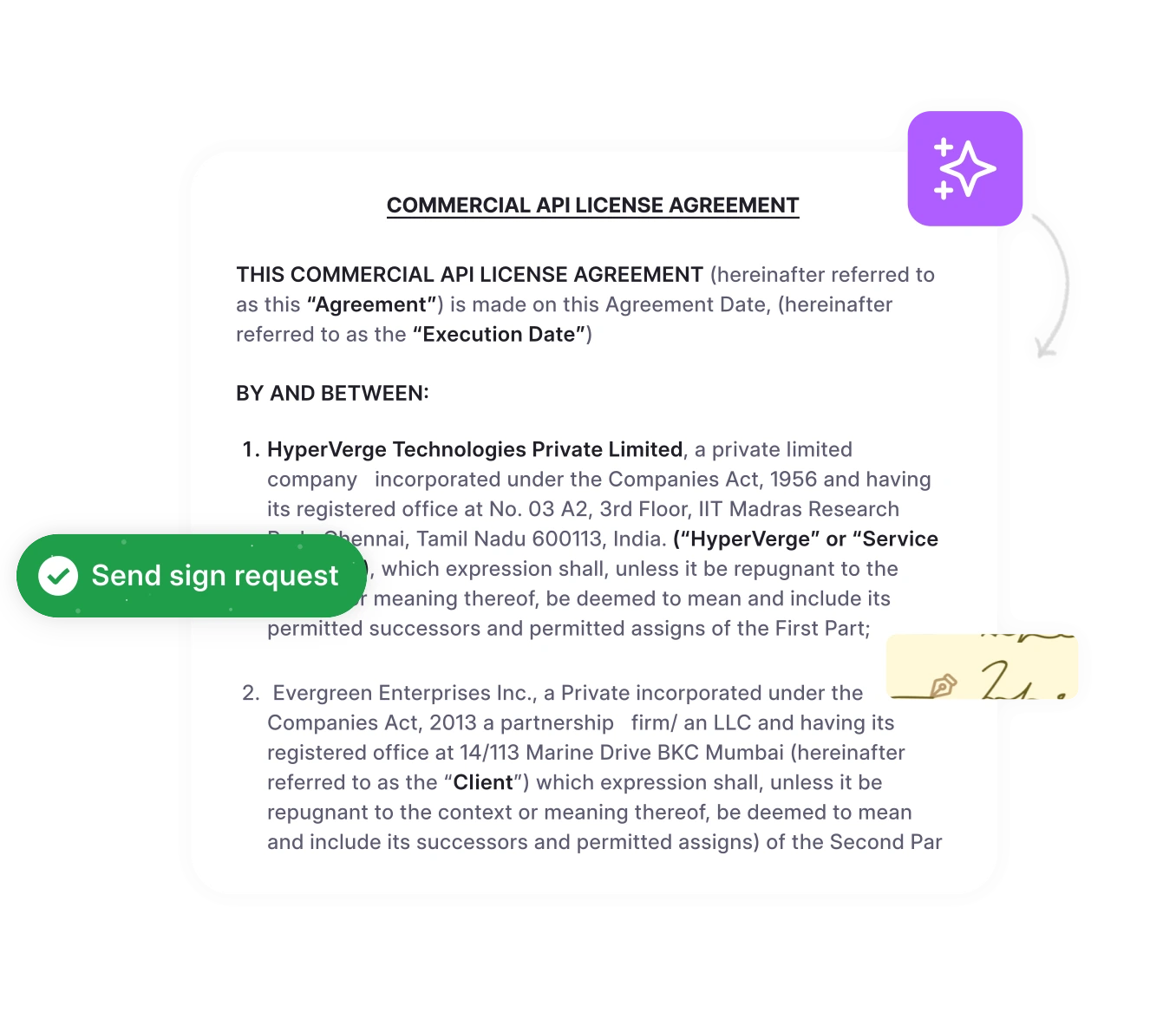Do you spend excessive time negotiating contracts? Is miscommunication hampering your contracting efficiency? Are your contracts failing to meet the objectives of key teams like finance and risk management?
If so, your contracting processes might be lacking collaboration. Contracting is often seen as the legal department’s responsibility, but in reality, it involves multiple stakeholders—including sales, finance, operations, and other teams.
According to a report by EY, a global leader in professional services and consulting, inefficiencies in contracting processes are slowing revenue recognition and resulting in lost business for more than 50% of organizations. This highlights the critical need for collaborative contract management to streamline workflows and improve business outcomes.
So, how can you ensure that your contracts serve the interests of all stakeholders and align with their objectives? The answer is simple–by implementing collaborative contract management strategies.
This blog explores practical tips and insights for adopting collaborative practices that turn contracting into a collective, streamlined effort. Let’s get started.
What is collaborative contract management?
Collaborative contract management is an approach to managing contracts that involves all key stakeholders in the contract lifecycle management process. A collaborative CLM ensures a streamlined, transparent contracting lifecycle where all parties have a say in the process.
Unlike traditional siloed processes, collaborative contract management emphasizes open communication and shared responsibilities. At every stage of the CLM process—creation, review, redlining, negotiation, acceptance, and monitoring—collaboration reduces friction between stakeholders and ensures everyone’s interests are met.
Creating a Single Source of Truth (SSOT) for contract data minimizes miscommunication and bottlenecks, enabling organizations to achieve faster contract turnaround times and better compliance.
Who Should Collaborate for Contracting Processes?
For contractual processes to be collaborative, it is essential that all stakeholders, internal and external, are involved in the contract management process from the beginning.
Here are the key stakeholders to involve to ensure collaborativeness in contract management:
Department heads: Define objectives and approve amendments to align contracts with business goals.
Contract parties/stakeholders: Provide input on deliverables, negotiate terms, and ensure obligations are met.
Contract manager: Oversee the contract lifecycle, track deadlines, and ensure workflows are followed.
Legal team: Draft and review terms for compliance, mitigate risks, and resolve disputes.
Finance team: Align terms with budgets, manage payments, and monitor financial metrics.
Procurement managers: Evaluate vendors, negotiate terms, and ensure adherence to procurement policies.
Compliance team: Monitor adherence to regulations, policies, and industry standards.
Involving these teams is the way to drive effective collaborative contract management. There are a few best practices for contract management to be truly collaborative. The next section covers them.
Manage contracts with automations at every step
Automate routine contracting tasks with HyperStart CLM—the smart contract management software for smart businesses. Enhance collaboration and improve contracting efficiency.
6 Ways to make contract lifecycle management more collaborative
Here are 6 tips to ensure a streamlined and collaborative contract management process in your CLM lifecycle.
1. Centralize contract data
Decentralized contract storage creates isolated silos of information where cross-functional teams have little to no information on contractual processes.
With a lack of visibility over the contract portfolio, business teams lack essential contract data to make decisions and track progress.
Central contract storage helps maintain a single source of truth where all teams can access the contract data easily.
Storing agreements in a centralized contract repository improves contract visibility and allows all business teams to understand and fulfill obligations.
2. Fast track redlining
Drafted contracts must be reviewed and redlined by all stakeholders to ensure all parties’ interests are met.
Isolated redlining increases negotiation time since each stakeholder requires time to review, redline, and negotiate their part in the contract.
Collaborative redlining helps cut slack on contract negotiation cycles, ensuring all stakeholders work collaboratively.
Reduced negotiation time helps speed up the contract review time, improves contract turnaround time, and ensures all stakeholders’ interests are met.
Traditional redlining in isolation results in multiple conflicting versions, increasing negotiation delays. Modern tools like HyperStart CLM allow AI-powered redlining that accelerates negotiations while maintaining accuracy.
3. Use contract management software to centralize collaboration
Manual contract management is prone to inefficiencies and information silos where only legal teams manage and share information internally.
When information is concentrated within legal teams, other departments rely on legal staff to get information on contracts’ progress and updates.
Contract management platform—like HyperStart CLM—helps share contractual information across the organization—ensuring everyone can access the latest insights.
With all departments’ access to contract data, tasks like obligation management and risk tracking become easier.
4. Connect with business-wide software
Different business teams like sales, HR, finance, and procurement use different software to manage their operations.
Contracts run as the common thread between multiple departments, making their connectivity with overall operations a must.
By connecting your contractual processes with cross-department software like CRM tools, HRMS, and accounting software, you can get better collaboration in contracting. Integration with Salesforce or HubSpot allows sales teams to generate contracts directly within the CRM, reducing turnaround times and errors.
Some of the best contract lifecycle management tools, like HyperStart CLM, integrate well with business apps, ensuring better collaboration and connectivity.
5. Track the right metrics and contractual KPIs
Contract management KPIs are metrics that help evaluate the performance and success of CLM processes.
It is important to track the right KPIs and metrics to get the right data, ensuring success in contracting.
Tracking the right KPIs like contract status and cycle times improves clarity among stakeholders, ensuring everyone understands progress and aligns on priorities.
Monitoring contract metrics such as turns taken and review time helps identify bottlenecks, allowing teams to address issues collaboratively and in real time.
These are 6 ways for collaborative and effective contract management. However, what are the benefits of making contractual processes collaborative? Let’s find out.
4 Benefits of making contract management processes collaborative
Collaboration is the key to streamlining contract management efforts for synchronized, aligned results. Here are 4 noteworthy benefits of collaborating in contract management:
1. Improves cross-departmental transparency
Collaborative contract management promotes sharing information and knowledge with all key stakeholders. With teams like legal, procurement, sales, and finance having common knowledge of contracts with counterparties, there are reduced chances of miscommunications.
A company’s sales team closes deals with vendors with specific delivery timelines, but the procurement team remains unaware of such timelines, leading to delays in contract execution. Collaborative contract management offers stakeholders real-time data access, ensuring everyone is aligned with contract requirements.
2. Speeds up negotiation cycles
With shared inputs from stakeholders, it becomes easy to negotiate deals. Collaborative contract management solutions like HyperStart CLM facilitate real-time, simultaneous contract negotiations, enabling stakeholders to share and achieve their interests faster. Real-time collaboration features allow stakeholders to work on a single version of the contract, reducing time spent on reconciliations.
A legal team and a vendor go through multiple email threads to finalize contract clauses, causing misinterpretations and delays. A collaborative platform enables both parties to work on the same document in real time, speeding up negotiations.
3. Mitigates contractual risks
With holistic insights into contracts’ performance, organizations can track their risks efficiently. Ensuring all stakeholders are aware of legal and regulatory requirements minimizes and mitigates risks through collaborative inputs.
A business misses an update in a contract compliance regulation that should have been included in contracts, exposing it to penalties. Collaborative tools notify all internal and external stakeholders of updates, enabling timely contract amendments to meet regulatory standards.
Collaboration in contract management is the key to achieving growth and improving contracting efficiency. It is a way to ensure contracting objectives are met effectively.
However, for streamlined contracting, you need a smart platform that facilitates collaboration, like HyperStart CLM.
Negotiate contracts 75% faster with HyperStart CLM
Use AI technology to review and redline counterparty papers 10x faster. Get to a yes faster with collaborative negotiations.
Collaborate for Contracts 80% Faster with HyperStart CLM
Contract collaboration is the key to ensuring efficiency and reducing friction in CLM processes. With all stakeholders contributing to contract management, it becomes easier to streamline the entire contract lifecycle.
HyperStart CLM is a unified contract lifecycle management software offering features to create, review, redline, negotiate, sign, store, track, and analyze contracts in one place. Built using AI technology, HyperStart CLM helps improve contract collaboration by unifying contracting processes to a single platform.
Want to know more about how HyperStart CLM can help you collaborate for contracts better? Book a demo with us today and start with a 14-day free trial to experience seamless CLM collaboration.









![A Guide to Contract Redlining [Challenges + Solutions + Top Software Tools]](https://www.hyperstart.com/wp-content/uploads/2024/07/Blog-82-purple-scaled.webp)

